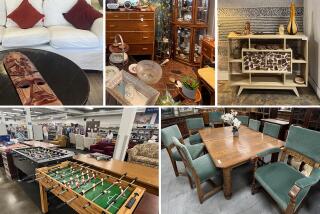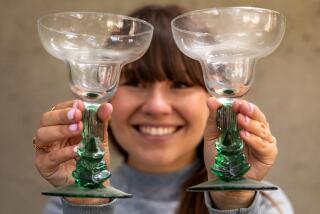Valued Opinions : Appraisers Put In Two Cents’ Worth to Help Determine What’s Precious, What’s Not
- Share via
For Roberta Gauthey, a Laguna Beach appraiser, it was the case of the coffeepot that almost got away.
Gauthey had just finished examining the furnishings inside a San Clemente residence when the owners mentioned that they had a pile of stuff sitting in their garage that they were about to give away. Gauthey immediately asked if she could take a look. There, among the discards, sat an old pewter coffeepot filled with “greasy, plastic flowers.” Gauthey inspected the pot, then flipped it over and studied the manufacturer’s stamp.
“That pot was an Early American coffeepot. It was worth more than anything in their house,” Gauthey says. She later estimated the pot’s value at $2,000.
Such tales of hidden treasure are common among appraisers. Individuals, they say, often have no idea how much their possessions are worth.
That’s where appraisers come in. They act as sleuths to track down the identity and value of objects in the home. Sometimes their digging unearths unexpected booty.
Louise Litwack, an appraiser in Corona del Mar, remembers one couple’s delight upon learning that a collectible fountain pen they owned was worth more than $10,000.
“They had no idea,” she says. “They would have been happy if it was worth $3,000.”
More often, however, people overestimate the value of their stuff.
“They think they have real Chippendale furniture and it turns out to be an anniversary piece that was made 100 years later,” Gauthey says. “Or they think they have a Tiffany lamp that turns out to be plastic.”
Family gossip is usually to blame for the inflated estimates.
“A lot of times it’s hearsay,” Gauthey says. “They’ll call and say, ‘This piece has been in my family for 200 years,’ and I’ll say, ‘But it’s an electric lamp. I don’t think so.’ ”
Litwack once appraised an etching that the owners assumed was a valuable original by Salvador Dali. It turned out to be a worthless fake.
*
Small pieces can be brought into an appraiser’s office to be evaluated, but often appraisers go the the client’s home and study its contents. They record each piece’s condition, characteristics, size, history of ownership, manufacturer and other details that affect its value, Litwack says.
They look for clues to establish the age of the object, such as the piece’s construction, shrinkage of the fabric and even the color of the wood, Gauthey says. They check if the furnishing has been refinished and has all of its original hardware.
“The more original the piece, the more valuable,” Gauthey says.
Then they dig through research materials to calculate the object’s value. Most appraisers have libraries of antique trade publications, price guides for specific collectibles such as Depression glass and records from major auction houses. Sometimes they call on experts in specialized areas such as fine arts, jewelry or pottery.
“No one person can know everything. I call on the best people in the field,” says Gauthey, who has turned to members of the Gemological Institute of America when confronted with a large gem or to museums when appraising a fine painting.
Mary Colby, a San Clemente appraiser, studied obscure books on pottery to uncover the identity of a vase that a young woman had planned to sell at a garage sale for $35. Colby’s search paid off. She found out the vase was made in the early 1900s at a sanitarium in Fairfax where tuberculosis patients were renowned for their pottery. The vase was worth $750.
“I’ve been appalled by the things people throw away,” Colby says. “Art pottery that people think is junk can go for $8,000.”
After researching the items, appraisers issue a written report with a detailed description of each object and an estimate of its value.
*
Appraisals do not come cheap--fees for the service average $100 an hour. Yet there are situations that make an appraisal a wise investment for people of all income levels.
“Sometimes people think they’ll save money by not having an appraisal. They figure, ‘Why should we pay?’ But they can give away things worth hundreds or thousands (of dollars) for nothing,” Gauthey says. “You should find out what you have before you sell something.”
Those who inherit an estate should have it appraised if they do not know the value of the items, Gauthey says.
“I appraised one estate and in among the things they were going to discard were two very fine paintings,” she says. “I said, ‘My God, those are worth hundreds of thousands of dollars.’ ”
Homeowners use written appraisals when insuring one-of-a-kind furnishings such as antique bedroom sets or handmade quilts.
“These are things you can’t go to the department store and replace,” Gauthey says.
Appraisals can prove beneficial in the wake of catastrophes such as theft, fire and earthquakes. They provide documented proof to insurance companies and the Internal Revenue Service when claiming the loss of valuables, Litwack says.
“Often after a loss people don’t remember what they had,” she says. “They can do their own inventory but many times they don’t know the value of their objects.”
People call on appraisers when they want to donate an item to charity and write it off on their tax returns. Appraisals are recommended by the IRS if the item is worth over $500 and required if it is over $5,000, Litwack says. Appraisers can also be called in when property is being divided in a divorce.
*
Those who need to hire an appraiser should choose one with care.
There is no state license required to become a personal property appraiser. Consumers should look for appraisers who are certified by a nonprofit professional association such as the American Society of Appraisers, whose members must complete an education program and follow a code of ethics.
They should also choose an appraiser who specializes in their type of property.
“You wouldn’t have an Early American art dealer appraise your Oriental furnishings,” Gauthey says.
The cheapest appraiser is not necessarily a bargain; an unscrupulous or unqualified appraiser can cost one money in the long run.
Gauthey suggests avoiding those appraisers who charge a percentage of the total value of the items appraised.
“Unfortunately there are unscrupulous people who put high prices on items and take a percentage” to reap a bigger fee, she says.
Before the appraisal, consumers should receive a contract from the appraiser that specifies the payment schedule and estimated number of hours the appraisal will take based on the number of objects to be examined, Litwack says.
Those who are curious about just one or two items can often get a free unofficial estimate of its worth from a willing appraiser.
Little John’s Antique Arms in Orange offers verbal ballpark estimates of an item’s value if one brings the item (or, in the case of a large furnishing, a picture of it) into the store, says Peter Oppenhuizen, a researcher at Little John’s.
People often find that pieces are not as valuable as they thought, but that does not mean they are not worth keeping.
“If you have Grandma’s sugar and creamer and you think it’s rare but it turns out to be worth only $10, keep it,” Oppenhuizen says. “It has a lot of memories.”
And no one can put a price on those.


